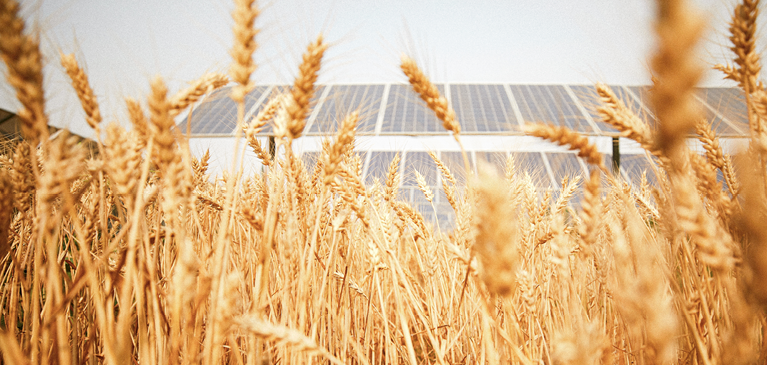
“Despite all our accomplishments, we owe our existence to a six-inch layer of topsoil and the fact that it rains.” – Attributed to Paul Harvey
Owed in large part to federal and state subsidies, solar developments are becoming more commonplace, especially on farmland. What is the future of solar, and, more importantly, for the farming community, and for a society that depends on plentiful food, what is the potential impact of solar development on agricultural property?
Growth of Solar
In 2000, solar power in the U.S. accounted for .59 GW of energy. By 2024, that skyrocketed to 177.59 GW of energy. However, despite this impressive growth, according to the U.S. Energy Information Administration, solar energy still accounts for only 4% of the United States’ energy generation.
While the solar footprint is relatively small now, the U.S. Department of Energy (DOE) projects solar energy will rise from 4% of our nation’s total energy production to 45% by 2050. If this prediction holds, it would require as much as 10.4 million acres of land. The DOE further states that 90% of the development will be in rural communities, including farms (Source: American Farm Bureau).
Put another way, the DOE estimates solar energy could provide 1 terawatt of electricity-generating capacity to the grid by 2035, which would require the use of 5.7 million acres of land. They also state solar is likely to conflict with agricultural land use because the same attributes that make land appropriate for solar energy (plentiful sun, flat land) are also attractive for agriculture.
Moreover, energy demands are not going to abate. With the growth of artificial intelligence and data centers, energy demands are growing rapidly. Some companies (Amazon and Google) are building their own small nuclear reactors to meet their energy needs.
Concerns for Farming and the Environment
Setting aside the obvious monetary incentives of leasing agricultural land for solar, below we discuss some of the environmental/ecological concerns.
Historically, there has been concern about the potential for metals (used in the production of solar panels) to leach from the panels to the soil. However, most studies to date conclude that this is not a concern. However, other larger concerns may be even more consequential.
According to American Farmland Trust, “About 83% of new solar projects are installed on farmland and ranchlands, with almost 50% placed on the most productive, versatile, and resilient land.”
An analysis by Reuters (2024) concludes that the renewable energy boom risks damaging some of America’s richest soils in key farming states. Reuters based its analysis on federal, state, and local data; hundreds of pages of court records; and interviews with more than 100 energy and soil scientists, agricultural economists, farmers, and farmland owners. Their analysis also included local, state, and federal lawmakers.
The Reuters article goes on to say that Farmland Partners, a Real Estate Investment Trust, has leased about 9,000 acres nationwide to solar firms. The Executive Chairman for the company states this includes ground that is highly productive and admits that solar is not likely the best use for the property, but that “our investors would kill us if we didn’t pursue this.”
Ecological Concerns
The largest solar power plant in the world is the Ivanpah Solar Plant. This massive solar plant is located in the Mojave Desert in California. According to the Association of Avian Veterinarians (2023), the Ivanpah Solar Plant is believed to be responsible for “at least 6,000 bird deaths each year, as the birds can suffer severe burns or become incinerated if they fly too close to the 40-foot towers that concentrate sunlight from five square miles of solar panels. These numbers are likely an underestimation, as the sight of birds and insects rapidly immolated as they soar too close to the towers, which can reach temperatures of 1,000 degrees Fahrenheit, is so common that staff at the plant have a name for them; ‘streamers.’”
The Ivanpah facility is an extreme example of the impact of solar facilities on the environment. Further studies on more “typical” solar facilities may help understand the impact on the local environment.
Is the Energy Tide Changing?
The impetus for “green energy” projects stems from concerns about anthropogenic greenhouse gases (GHGs) and their impact on global temperatures. However, with the change in administration, there is a change in philosophy for both GHGs and energy in general.
Under the recently passed One Big Beautiful Bill Act, tax incentives for clean energy projects have been rolled back. Under the new law, tax credits for wind and solar projects phase out sooner than those for other technologies, like storage. To qualify, these projects must either be completed by the end of 2027 or begin construction by July 4, 2026 (Source: Latham and Watkins). Accordingly, the financial incentive may not be as big a carrot to entice farmers to lease land for solar farms.
From the DOE’s new Climate Assessment Report, “Climate change is real, and it deserves attention. But it is not the greatest threat facing humanity. That distinction belongs to global energy poverty. As someone who values data, I know that improving the human condition depends on expanding access to reliable, affordable energy” - Secretary Chris Wright, U.S., DOE.
The effect of placing solar panels on farm fields deserves attention, as we cannot afford to jeopardize the irreplaceable Breadbasket of America. Using productive farmland for low-density energy forms such as solar and wind may not be in our best interest as we balance two critical needs – energy and food.
To view the rest of the 2025 fall Partners articles please click here.


